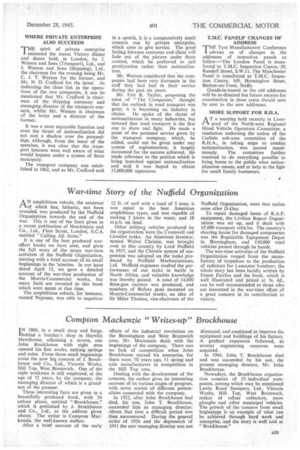War-time Story of the Nuffield Organization
Page 31

If you've noticed an error in this article please click here to report it so we can fix it.
AN amphibious vehicle, the existence of which has, hitherto, not been revealed, was produced by the Nuffield Organization towards the end of the war. This is one of the facts given in a recent publication of Hutchinson and Co., Ltd., Fleet Street, London', E.C.4, entitled "Calling All Arms."
It is one of the best produced wareffort books we have seen, and gives the full story of the many war-time activities of the Nuffield Organization, starting with a brief account of its small beginnings in the 'nineties. In our issue dated April 13, we gave a detailed account of the war-time production of the Morris-Commercial works, but many facts are revealed in this book which were secret at that time.
The amphibious vehicle, for instance, named Neptune, was able to negotiate 12 ft. of surf with a load of 5 tons; it was equal to the best American amphibious types, and was capable of making 5 knots in the water, and 18 m.p.h. on land. Other vehicles produced by the organization were the Cromwell and Cavalier tanks. An American inventor, named Walter Christie, was brought over to this country by Lord Nuffield in 1937, and the Christie system of suspension was adopted on the tanks produced by Nuffield Mechanizations, Ltd. Nuffield engineers studied the performance of our tanks in battle in North Africa, and valuable knowledge was thereby gained. A total of 14,000 Bren-gun carriers was produced, and numbers of Bofors guns mounted on Morris-Commercial trucks, an idea of Sir Miles Thomas, vice-chairman of the
Nuffield Organization, went into action soon after D-Day. To repair damaged items of R.A.F. equipment, the Civilian Repair Organization was set up, and it dealt with 65,000 transport vehicles. The country's clearing house for damaged components was the Repairable Equipment Depot in Birmingham, and 150,000 road vehicles passed through its hands.
The war-time activities of the Nuffield Organization ranged from the manufacture of torpedoes to the production of radiators for Lancaster bomberr, the whole story has been lucidly written by Ernest Fairfax and the book, which is well illustrated and inked at 7s. 6d., can be well recommended to those who are interested in the war-time effort of a great concern in its contribution to victory.




































































